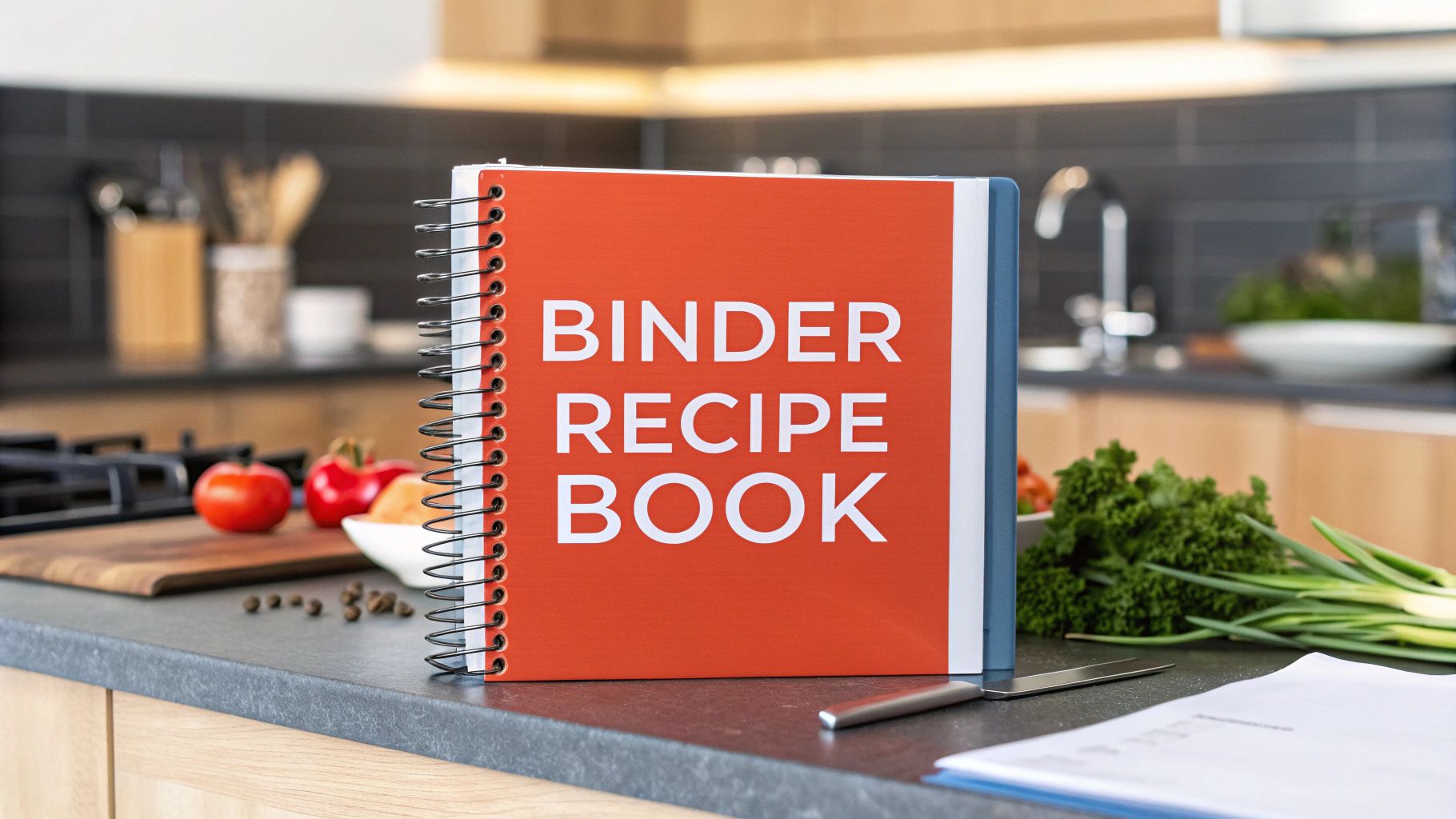Why Every Home Chef Needs a Binder Recipe Book
Let's be honest: digital screens can be unreliable in the kitchen. Loose recipe cards disappear. A physical binder recipe book offers a dependable and lasting solution. Consider it your personalized culinary hub, protecting treasured recipes from spills and tech failures. It's a tangible link to your cooking history, a growing collection enriched with every new dish.
A surprising 8 out of 10 professional chefs keep physical recipe collections, even in our digital age. This demonstrates the enduring practicality of a well-organized binder system.
The desire for tangible recipe organization has a rich history. The recipe box became popular in the 1920s alongside the rise of women's magazines offering perforated recipe cards. This reflects the increased focus on precise measurements and detailed instructions, leading to personalized collections often kept in repurposed boxes or tins. Cookbook People offers more information on the history of the recipe box. The first commercial recipe box, from Betty Crocker and Gold Medal Flour in 1920, even included a card filing system and a recipe subscription service.
Benefits of a Physical Recipe Binder
A binder recipe book has several advantages. It allows easy reorganization, adapting to your changing tastes and culinary adventures. As you explore new cuisines or dietary needs, simply rearrange sections or add categories. This flexibility keeps your collection useful and up-to-date.
A binder also serves as a safe place for cherished family recipes, handwritten notes, and cooking stories. These personal details turn it into a living family history, linking generations through food.
Building Your Culinary Legacy
Your binder becomes more than just recipes. It evolves into a tangible heirloom, preserving family history and memories alongside favorite dishes. Imagine sharing your grandmother's handwritten cookie recipe, complete with her notes.
This is the power of a binder – capturing the essence of family traditions and ensuring they aren't forgotten. This personalized collection inspires and connects, fostering a love of cooking across generations. It's a physical expression of your unique culinary style.
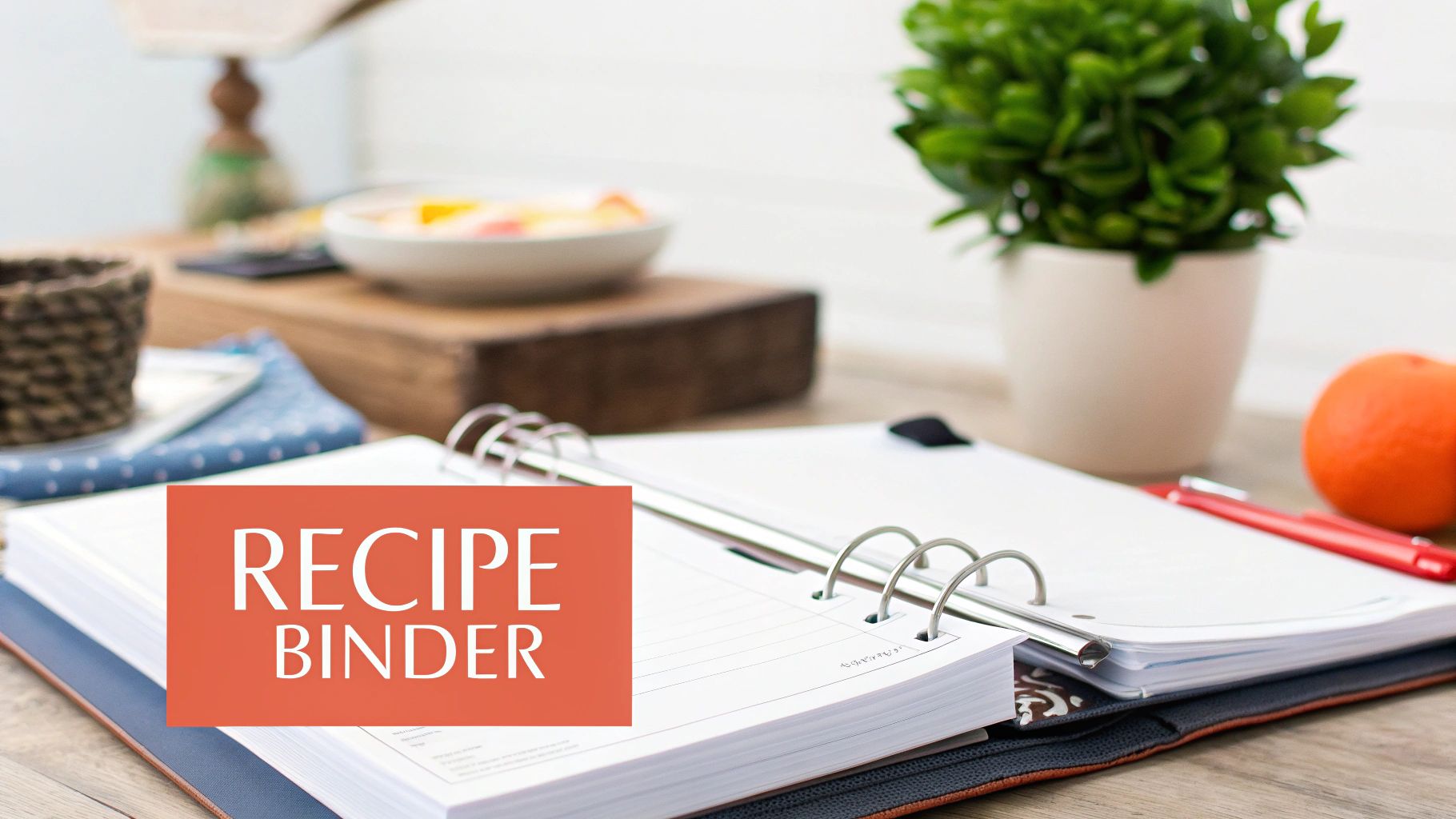
Selecting Your Perfect Recipe Binder: Materials Matter
A binder recipe book is more than just a collection of recipes; it's a personalized culinary companion. Choosing the right materials ensures it can handle daily use and the occasional kitchen mishap. This careful selection elevates a simple binder into a treasured kitchen essential. Professional chefs often prioritize durable, easy-to-clean materials for their own recipe collections, emphasizing practicality for a busy kitchen environment.
Binder Size and Capacity: Finding the Right Fit
Choosing the right binder size is essential for a well-organized recipe collection. A small binder will quickly overflow, while an oversized one becomes unwieldy. The right fit ensures your recipes stay organized and accessible. Standard binders typically hold 8-1/2″ x 11″ pages, perfect for printed web pages or magazine clippings. Mini binders are better for 5-1/2″ x 8-1/2″ pages, similar to traditional recipe cards.
The binder's ring size determines its capacity. A larger ring size allows for more pages and sheet protectors, accommodating future recipe additions. Using photo pages for 4″ x 6″ recipe cards in a standard binder is a popular option. Discover more insights about binder sizes.
To help visualize the different options, take a look at this comparison table:
Binder Size Comparison for Recipe Collections
This table compares different binder sizes and their suitability for various recipe formats and collection sizes.
| Binder Type | Dimensions | Best For | Capacity | Recommended Uses |
|---|---|---|---|---|
| Standard Binder | 8-1/2″ x 11″ | Full-page printouts, magazine clippings | High (depends on ring size) | Large recipe collections, printed web pages |
| Mini Binder | 5-1/2″ x 8-1/2″ | Smaller printouts, recipe cards | Medium (depends on ring size) | Moderate-sized collections, handwritten recipes |
| Photo Album Binder | Varies, often 8-1/2″ x 11″ | Photo-sized recipe cards (e.g., 4″ x 6″) | High (photo page capacity) | Visual recipe collections, recipe cards |
As you can see, different binder types cater to different needs and recipe formats. Consider your current collection size and potential future growth when making your choice.
Material Considerations: Durability and Practicality
The binder material significantly impacts its lifespan. Vinyl or poly binders offer excellent protection against spills and stains, crucial in a kitchen setting. For added durability, choose a heavy-duty binder with reinforced edges. This helps your binder withstand frequent use and accidental bumps. You might be interested in: How to master your recipe book.
Choosing the Right Page Protectors: Preserving Your Recipes
Protecting your recipes from splatters is essential. Sheet protectors are a must-have. Opt for heavy-duty, non-glare sheet protectors that wipe clean easily. Avoid flimsy protectors that tear easily or obscure the text. Acid-free sheet protectors preserve valuable handwritten recipes or vintage clippings, preventing yellowing or deterioration over time.
Dividers and Tabs: Organizing Your Culinary Collection
A well-organized recipe binder makes finding your favorite dishes easy. Dividers with clear tabs enable efficient categorization. Color-coded dividers can further organize recipes by cuisine, course, or occasion. Durable dividers with reinforced tabs will hold up to repeated use.
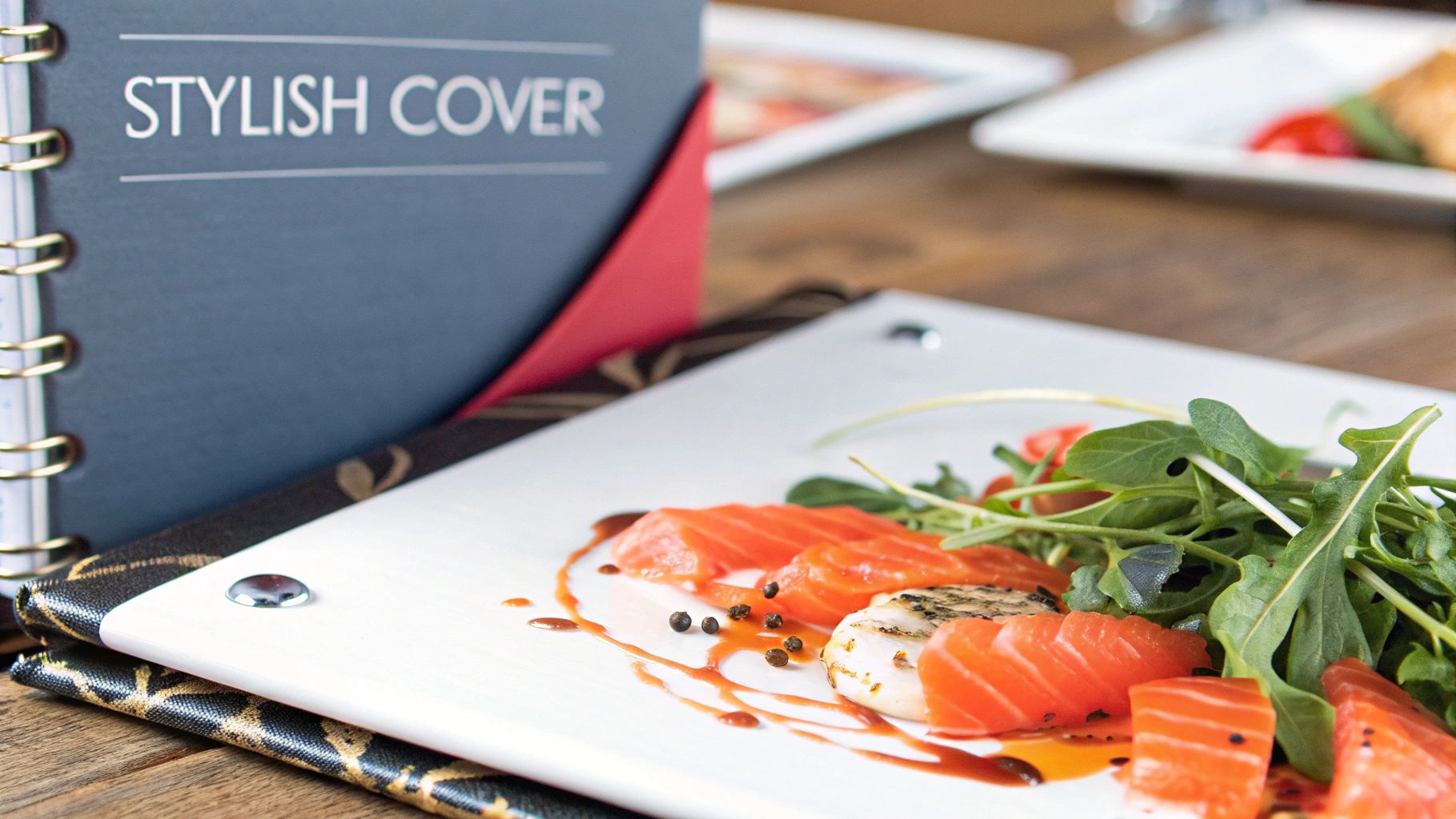
By carefully selecting these materials, you'll create a binder recipe book that is both practical and beautiful, a reflection of your culinary passion. This investment will serve you well for years to come, enhancing your kitchen organization and enjoyment.
Essential Supplies: Building Your Binder Recipe Book Arsenal
Beyond the binder itself lies a world of organizational possibilities. Choosing the right supplies can transform a simple recipe collection into a cherished and highly functional kitchen companion. This means selecting the right tools is just as important as the binder itself. Let's explore the essential supplies that will elevate your recipe binder from simple to exceptional.
Protecting Your Precious Recipes: Page Protectors and More
Shielding your recipes from inevitable kitchen splatters is crucial. Sheet protectors are your first line of defense. However, not all sheet protectors are equal. For everyday recipes, heavy-duty, non-glare sheet protectors wipe clean easily.
For preserving handwritten family recipes or vintage clippings, consider archival-quality, acid-free sheet protectors. These specialized protectors prevent yellowing and deterioration, ensuring cherished recipes remain legible for years to come.
Dividing and Conquering: Choosing the Right Divider System
A well-organized binder needs a robust divider system. Dividers with clear tabs make browsing and retrieving recipes a breeze. Consider color-coding your dividers to categorize recipes by cuisine, course, or occasion.
For example, blue dividers might hold breakfast recipes, while green could be reserved for vegetarian dishes. This simple system dramatically improves navigation, especially for large collections.
Beyond the Basics: Additional Organizational Tools
While page protectors and dividers are essential, other tools can further enhance your binder. Sticky notes are perfect for marking favorite recipes or adding cooking notes. Binder pockets offer a convenient place to store loose clippings or recipe cards.
Even a decorative binder cover adds a personal touch and protects your binder from wear and tear. You might find this helpful: How to master digital recipe organization.
To help you gather everything you need, we've compiled a handy checklist:
Before we get into the details, here’s a quick overview of the essential supplies you'll need:
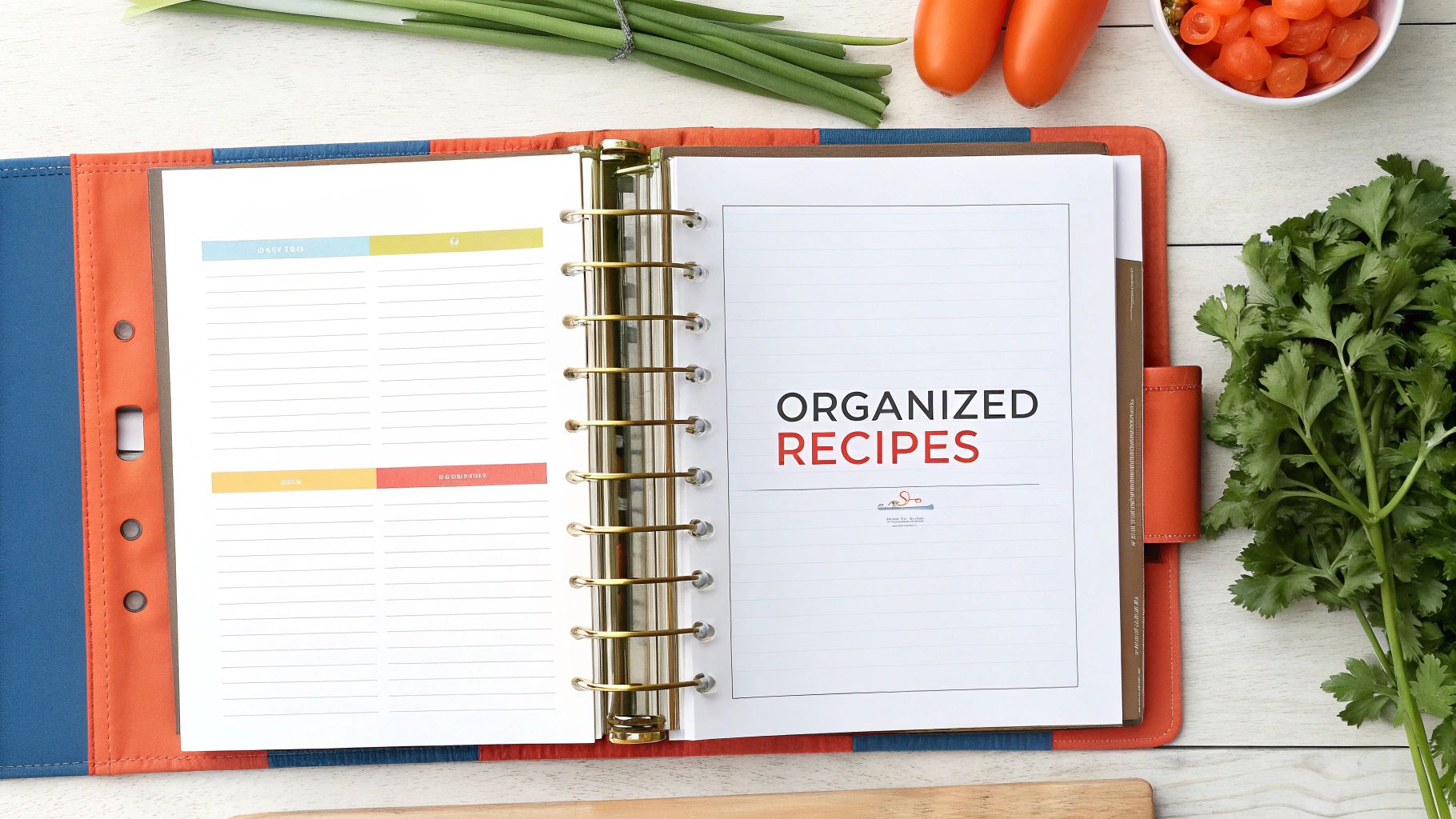
The following table provides a detailed list of essential supplies and recommendations for creating your perfect binder recipe book.
Essential Supplies Checklist for Recipe Binders
A comprehensive list of supplies needed to create a complete binder recipe book, with recommendations for each category
| Supply Item | Purpose | Recommended Features | Budget Option | Premium Option |
|---|---|---|---|---|
| Binder | Holds and organizes recipe pages | Durable, appropriate size | Vinyl Binder | Heavy-duty Poly Binder |
| Page Protectors | Protects recipes from spills and damage | Heavy-duty, non-glare, acid-free | Standard Sheet Protectors | Archival Sheet Protectors |
| Dividers | Separates recipe categories | Durable tabs, color-coded | Cardstock Dividers | Reinforced Tab Dividers |
| Tabs | Labels divider categories | Clear, writable | Pre-printed Tabs | Customizable Tabs |
| Sticky Notes | Marks favorite recipes, adds notes | Removable, various sizes | Standard Sticky Notes | Shaped Sticky Notes |
| Binder Pockets | Stores loose clippings, recipe cards | Secure closure | Plain Binder Pockets | Decorative Binder Pockets |
| Binder Cover | Protects binder, adds personalization | Durable, decorative | Clear Plastic Cover | Patterned Fabric Cover |
With these supplies, your binder recipe book becomes more than just a collection of recipes; it's a practical and cherished kitchen tool, a testament to your love of cooking, and a valuable resource for years to come.
Creating a Binder Recipe Book Organization System That Works
A binder recipe book is a great way to keep your favorite recipes organized. But simply sorting them into appetizers, main courses, and desserts might not be the most helpful system. Why? Because it doesn't reflect how we actually plan meals. Let's explore how to build a system that truly works, turning your binder into a go-to kitchen resource.
Organizing By Cooking Context: A More Intuitive Approach
Think about organizing your recipes by cooking context instead of general categories. This means grouping them based on situations like "Weeknight Meals," "Special Occasions," "Slow Cooker Recipes," or even "Recipes for Two." This approach makes it easier to find the right recipe for any situation. Imagine quickly finding a recipe in your "Quick Weeknight Meals" section instead of searching through a huge "Main Courses" category. This method mirrors how professional chefs often organize their collections, prioritizing efficiency.
Read also: How to categorize recipes.
The Power of Color-Coding and Cross-Referencing
Color-coding can make finding recipes much faster. Assign a color to each category and use matching dividers. This visual cue helps you quickly locate the section you need. Also, consider a cross-referencing system, a technique used by professional chefs. Create an index or separate section listing recipes under multiple categories. A "Chicken and Vegetable Stir-Fry" could be listed under both "Quick Weeknight Meals" and "Asian Cuisine," offering multiple ways to find it.
Customizing Your System: From Spontaneous to Meticulous
One of the best things about a binder recipe book is that it’s customizable. There's no single right way to do it. A spontaneous cook might prefer broad categories, while a meticulous planner might like detailed subcategories. If you cook based on ingredients on hand, organize a section by main ingredient like "Chicken," "Beef," or "Vegetables." You might be interested in: How to find the perfect personalized recipe binder. Personalized recipe binders also make unique gifts.
Examples of Organizational Frameworks
Here are some examples to help you get started:
- By Cuisine: Italian, Mexican, Asian, American, etc.
- By Course: Appetizers, Salads, Soups, Main Courses, Desserts, etc.
- By Cooking Method: Grilling, Baking, Slow Cooking, One-Pot Meals, etc.
- By Dietary Restrictions: Vegetarian, Vegan, Gluten-Free, Dairy-Free, etc.
- By Season: Spring, Summer, Autumn, Winter, etc.
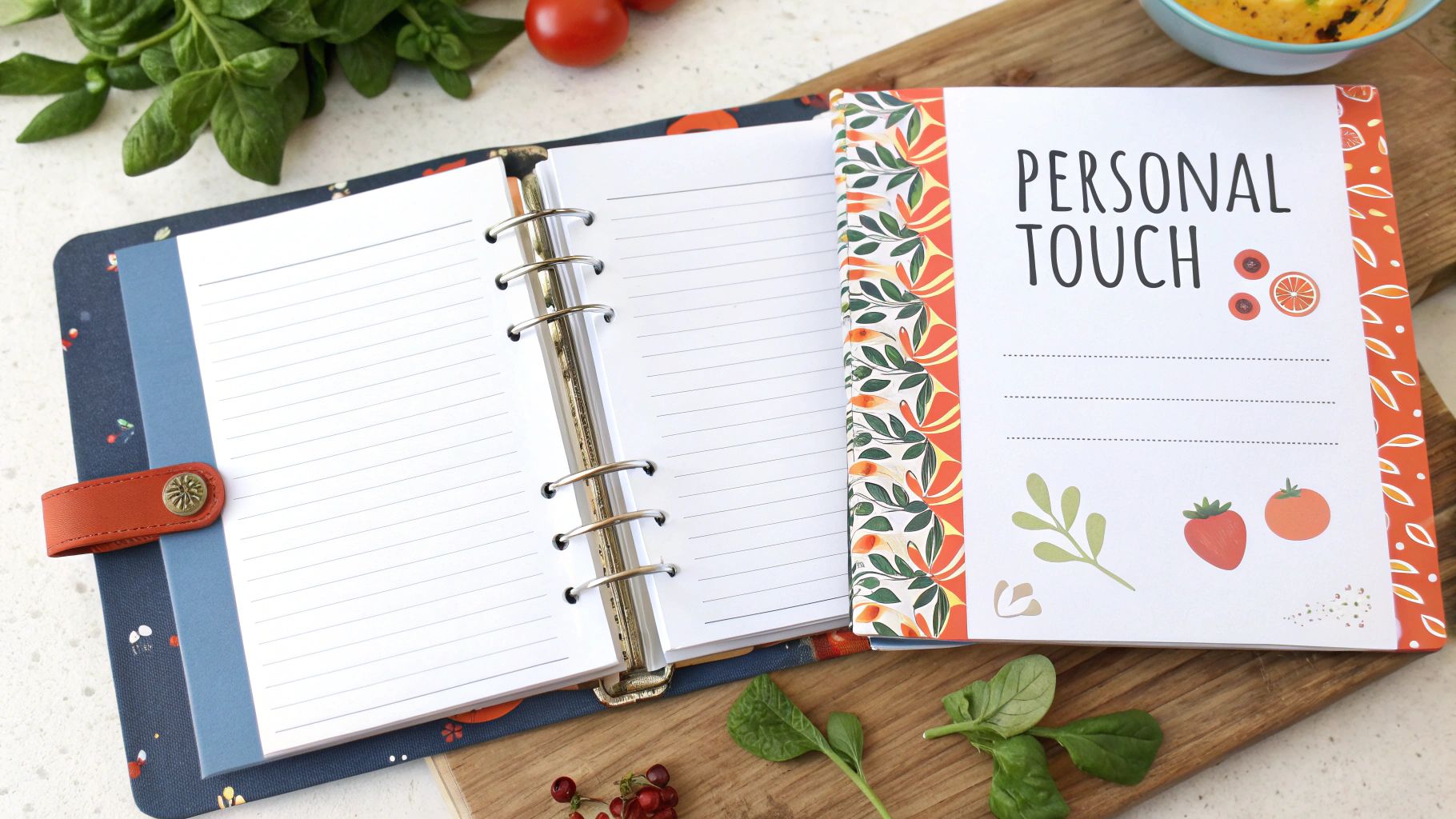
The best system is the one that works for your cooking style. Using these strategies, your binder will become more than just a recipe collection—it will be a valuable tool that simplifies cooking and sparks creativity.
Recipe Templates: The Secret to Binder Recipe Book Mastery
The key to a truly effective binder recipe book isn't just organization—it's consistent formatting. Just like musicians can read sheet music more easily with consistent notation, a standardized recipe format allows your brain to process cooking information more efficiently. This reduces cooking errors and speeds up your prep time.
Having all your recipes laid out the same way makes them easier to follow and saves valuable time in the kitchen.
Why Recipe Templates Matter
Imagine flipping through your binder looking for a specific recipe. With consistent formatting, you can quickly locate key information like ingredients and cooking times, no matter the dish. This visual consistency streamlines the cooking process, eliminating the need to decipher different layouts every single time. This is especially helpful when trying new recipes or cooking under pressure. One food blogger, reflecting on her own cooking habits, even admitted to relying heavily on her blog as a personal cookbook simply because it provides a consistent format for all her recipes.
Consistent formatting is a real game-changer for busy cooks.
Designing Your Ideal Recipe Template
Think about which layout elements work best for your cooking style. Some key components to include are:
- Recipe Title: Clear and descriptive.
- Yield: How many servings the recipe makes.
- Prep Time: How long it takes to prepare the ingredients.
- Cook Time: The actual cooking time.
- Ingredient List: Clearly listed with precise measurements.
- Instructions: Step-by-step directions written in a clear and concise manner.
- Notes: A dedicated space for personal modifications or serving suggestions.
Customizing your template makes it even more useful.
Adapting Existing Recipes to Your Template
You likely have recipes from various sources—cookbooks, websites, and maybe even handwritten cards. Converting these into a consistent format is crucial for binder recipe book mastery. Here are some tips:
- Rewriting: Rewrite recipes onto template pages. This offers the most control over formatting.
- Printing: Print web recipes, adjusting font size and layout as needed.
- Scanning and Editing: Scan handwritten recipes and edit them digitally for clarity and consistency. You might consider using optical character recognition (OCR) software for this.
- Photocopying and Cutting: Photocopy recipes and cut them to fit your template pages. This is a quick and easy method.
A little effort upfront saves a lot of time later.
Sample Templates for Different Recipe Types
Different recipe types might benefit from slightly different templates. A quick weeknight dinner template might prioritize a concise ingredient list and simple instructions, while a complex holiday recipe template might include space for detailed notes and variations. Consider creating separate templates for different categories, like:
- Quick Meals: Emphasize brevity and ease of preparation.
- Baking: Include specific baking temperatures and times.
- Slow Cooker Recipes: Highlight cook times and temperature settings.
- Preserving: Focus on detailed instructions and safety guidelines.
By implementing these strategies, your binder recipe book transforms into a powerful kitchen tool. Consistent formatting empowers you to cook efficiently and confidently, making every cooking experience more enjoyable.
Preserving Family Legacy Through Your Binder Recipe Book
Your binder recipe book can be more than just a collection of recipes. It can become a treasured heirloom, a vessel for family history, and a source of connection across generations. It's a way to preserve not just what your family eats, but the who, when, and why behind those meals. This means going beyond simply listing ingredients and instructions; it's about capturing the stories and memories that make these recipes truly special.
Capturing the Stories Behind Your Recipes
Every recipe has a story. Grandma's famous apple pie might have been a holiday tradition. Uncle Joe's chili might be a secret recipe passed down for generations. These stories add richness and depth to your binder, transforming it into a living family narrative.
A great way to capture these stories is through interviews. Talk to family members about their favorite recipes. Ask about their origins, special memories, and any variations or tips they've learned over time. Even small details, like who taught them the recipe, can add significant value.
Preserving Handwritten Treasures
Many families have handwritten recipe cards passed down through generations. These fragile documents are more than just recipes; they're tangible links to the past. Preserving them requires special care.
Consider using archival-quality, acid-free sheet protectors to prevent damage. Scanning or photocopying these cards creates a digital backup. These digital copies can then be printed and added to your binder, so you can use the recipes without risking the originals.
Extracting Cooking Wisdom: The Art of the Interview
Interviewing family members about their cooking can be rewarding, but also challenging. Many experienced cooks rarely measure precisely. They rely on intuition and experience—"a pinch of this" or "a dash of that."
To capture their wisdom, focus on understanding their process, not just exact measurements. Ask them to describe the look and feel of the dough, the sounds and smells that indicate doneness, and any other sensory cues they use. This preserves their unique techniques and knowledge.
Building a Living Family Narrative
To truly create a family heirloom, include more than just recipes. Add photos of family cooking or enjoying meals together. Include handwritten notes and stories alongside the recipes. These additions create a richer, more engaging experience.
For example, with Grandma's apple pie recipe, include a photo of her baking with her grandchildren or a note about using apples from the family orchard. These details create a powerful sense of connection. As your family grows, continue adding to the binder. New recipes, photos, and stories enrich the narrative, creating a living document that becomes more precious with time.
Ready to transform your recipes into a treasured heirloom? Recify can help you save and organize your recipes from online sources, making it easier to create your perfect binder recipe book. Learn more about Recify and start building your culinary legacy today!
